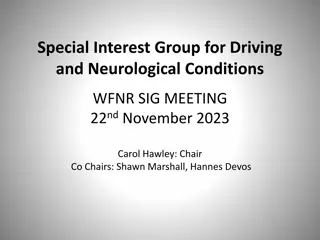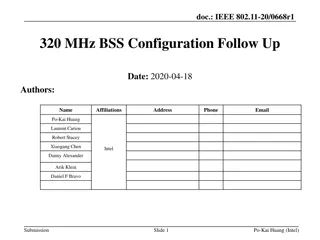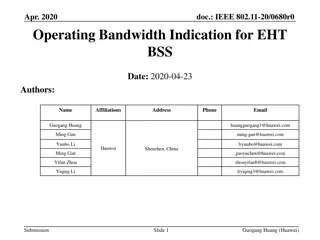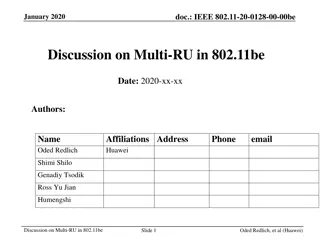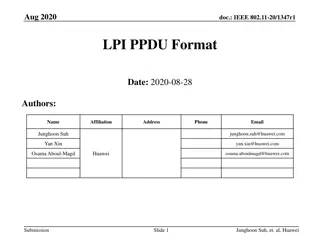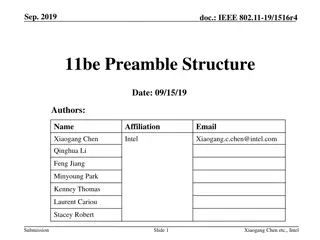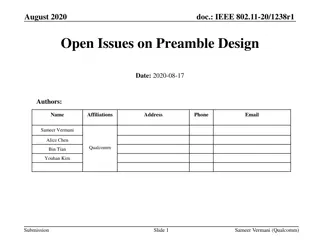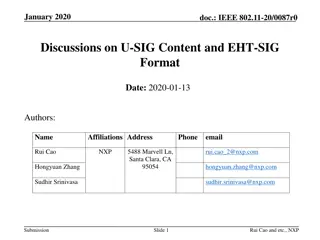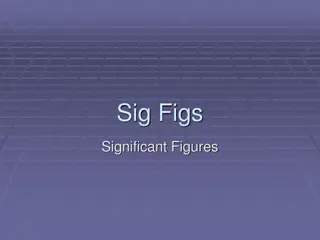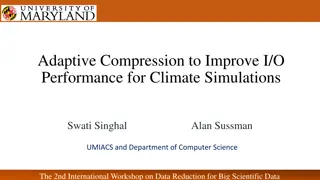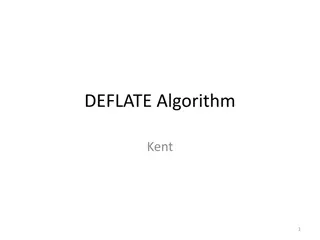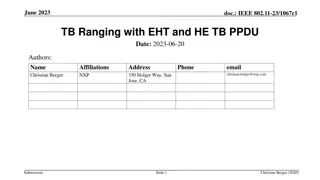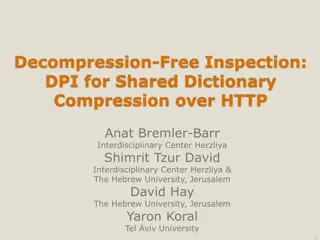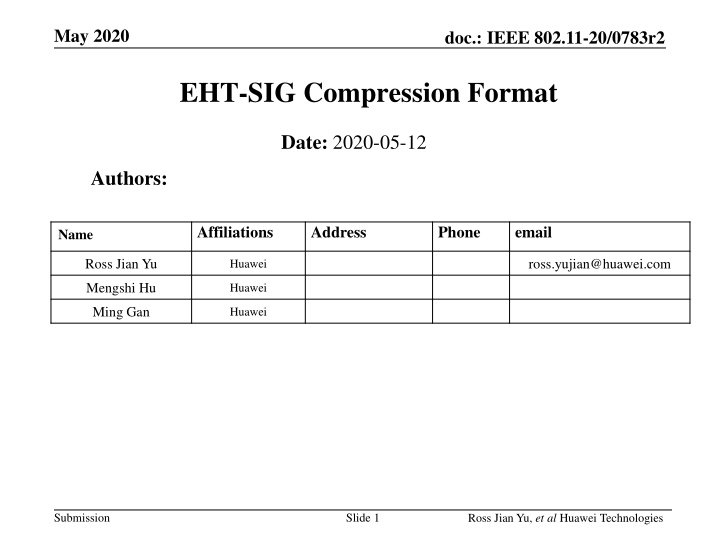
IEEE 802.11-20/0783r2 EHT-SIG Compression Modes Overview
Explore the compression modes introduced in IEEE 802.11 standards, including HE-SIG-B compression in 11ax and compression modes 1 and 2 in 11be. Learn about the different modes of EHT-SIG and the alignment requirements for MS-EHT-SIG in 11be for multi-segment structures.
Uploaded on | 5 Views
Download Presentation

Please find below an Image/Link to download the presentation.
The content on the website is provided AS IS for your information and personal use only. It may not be sold, licensed, or shared on other websites without obtaining consent from the author. If you encounter any issues during the download, it is possible that the publisher has removed the file from their server.
You are allowed to download the files provided on this website for personal or commercial use, subject to the condition that they are used lawfully. All files are the property of their respective owners.
The content on the website is provided AS IS for your information and personal use only. It may not be sold, licensed, or shared on other websites without obtaining consent from the author.
E N D
Presentation Transcript
May 2020 doc.: IEEE 802.11-20/0783r2 EHT-SIG Compression Format Date: 2020-05-12 Authors: Affiliations Address Phone email Name Ross Jian Yu ross.yujian@huawei.com Huawei Mengshi Hu Huawei Ming Gan Huawei Submission Slide 1 Ross Jian Yu, et al Huawei Technologies
May 2020 doc.: IEEE 802.11-20/0783r2 Recap 11ax SIG compression In 11ax, a compression mode of HE-SIG-B is introduced, there is no common field in HE-SIG-B for compression mode. In HE-SIG-A, there exist HE-SIG-B Compression field and Number Of HE- SIG-B Symbols Or MU-MIMO Users Field. When the HE-SIG-B compression field indicates 1, Number Of HE-SIG-B Symbols Or MU-MIMO Users Field indicates the number of MU-MIMO users and is set to the number of MU- MIMO users minus 1. In 11ax, for compression mode, the exact number of OFDM symbols in the HE- SIG-B field is calculated based on the number of User fields in the HE-SIG-B content Channel. Submission Slide 2 Ross Jian Yu, et al Huawei Technologies
May 2020 doc.: IEEE 802.11-20/0783r2 Recap 11be SIG compression In [1], two compression modes are proposed for 11be: Compression mode 1: Used for Full BW SU or Full BW MU-MIMO; RU allocation info in the common field is omitted Compression mode 2: Used for Punctured SU or Punctured MU-MIMO; RU allocation info in the common field is replaced by a punctured channel info with granularity of 20MHz Submission Slide 3 Ross Jian Yu, et al Huawei Technologies
May 2020 doc.: IEEE 802.11-20/0783r2 Three modes of EHT-SIG The following three modes are considered for EHT-SIG: Non-compressed mode (for OFDMA case): RU allocation subfields only, and the n umber of RU allocation subfields is equal to N, and N can be defined as in 11ax Compressed mode 1 (punctured non-OFDMA case): there is no RU allocation subfi eld, only one preamble puncture subfield or only one special RU allocation subfield , which contains entries for large MRU combinations. People may have different pr eference regarding terminology. Compressed mode 2 (non-punctured non-OFDMA case): no RU allocation subfield s/preamble puncture indication. This mode can also be seen as a special mode of co mpressed mode 1, where within the puncture indication/special RU allocation subfi eld, it indicates RU types of no puncture, e.g., 2*996, 3*996, 4*996. There should exist indication in U-SIG differentiating: Non-compression Mode, Compression Mode 1 and Compression Mode 2 Non-compression Mode and Compression Mode Under the above assumptions, we further discuss the alignment issues reg arding compression mode. Submission Slide 4 Ross Jian Yu, et al Huawei Technologies
May 2020 doc.: IEEE 802.11-20/0783r2 Alignment Requirement for MS-EHT-SIG In 11be, considering multi-segment EHT-SIG or A-PPDU structure [2,3], EHT- SIG needs to be aligned between each segments. The group has the following SPs in green [4,6] and this requirement is also mentioned in [2]: Submission Slide 5 Ross Jian Yu, et al Huawei Technologies
May 2020 doc.: IEEE 802.11-20/0783r2 Alignment issues of compression mode If 11be follows 11ax, the number of EHT-SIG symbols is reinterpreted as the number of MU-MIMO users for a non-OFDMA transmission, then the exact number of OFDM symbols in the EHT-SIG field is calculated based on the number of User fields in the EHT-SIG content Channel: For sub-PPDU-2 with 2 users full MU-MIMO, in each CC, there only exists 1 user field with CRC and tail. Assuming 38 bits, and also assume 4 bits U-SIG overflow info, with MCS 0, then there will be 2 EHT-SIG symbols for sub-PPDU-2. The above method cannot indicate the exact number of EHT-SIG symbols after padding. Aggregated PPDU Sub-PPDU-3 (non-compression mode with 8 EHT-SIG symbols) Sub-PPDU-2 (2 users, full BW MU-MIMO), need to padding to 8 EHT-SIG symbols 80MHz 80MHz Sub-PPDU-1 (non-compression mode with 8 EHT- SIG symbols) 160MHz Hence, compression mode cannot be applied (also mentioned in [2]). Or we can say with MS-EHT-SIG or A-PPDU structure, compression mode can be seldom applied in EHT PPDU. Submission Slide 6 Ross Jian Yu, et al Huawei Technologies
May 2020 doc.: IEEE 802.11-20/0783r2 Simple solution to enable compression mode If the number of EHT-SIG symbols is always used to indicate number of EHT-SIG symbols and not reinterpreted as anything else. Then the issue is solved. Enable alignment all the time For the number of MU-MIMO users field (up to 4 bits), it is indicated in the common field of the EHT-SIG instead. May be only needed for compression mode, can also be merged to preamble puncture indication The cost of maximum 4 bits saves the overhead of one or multiple RU allocation subfields (8/9/10 bits multiplies by N) variable symbol 2 symbols ... RL- SIG EHT-SIG L-STF L-LTF L-SIG U-SIG 0 or TBD bits 4 bits Preamble puncture indication Number of MU-MIMO users Number of EHT-SIG Symbols (5 bits) ... ... ... CRC+Tail User specific field Submission Slide 7 Ross Jian Yu, et al Huawei Technologies
May 2020 doc.: IEEE 802.11-20/0783r2 Extending applicable scenario of compression mode Level 0: if 11be follows 11ax, then compression mode can seldom be applied. Can only be applied if no alignment is needed, usually non-OFDMA transmission across the whole BW. Also cannot be applied in A-PPDU concept Level 1: By the previous simple solution, compression mode can be further applied if the transmission is non-OFDMA within a sub-PPDU. 4 4 10 28 10 U-SIG Overflow MU- MIMO # EHT-SIG CC11 CRC+Tail CRC+Tail User field 1 L-preamble+U-SIG1 U-SIG Overflow MU- MIMO # EHT-SIG CC12 Data CRC+Tail User field 2 CRC+Tail L-preamble+U-SIG1 STA1,2 Padding MU-MIMO (STA1-STA2) MU- MIMO # U-SIG Overflow BW=80Mhz EHT-SIG CC11 CRC+Tail CRC+Tail User field 1 L-preamble+U-SIG1 EHT-SIG CC12 MU- MIMO # U-SIG Overflow L-preamble+U-SIG1 CRC+Tail User field 2 CRC+Tail U-SIG Overflow MU- MIMO # EHT-SIG CC21 User field 3 User field 4 CRC+Tail CRC+Tail L-preamble+U-SIG2 U-SIG Overflow MU- MIMO # EHT-SIG CC22 Data CRC+Tail User field 5 User field 6 CRC+Tail L-preamble+U-SIG2 MU-MIMO (STA3-STA6) STA3-STA6 U-SIG Overflow MU- MIMO # EHT-SIG CC21 User field 3 User field 4 CRC+Tail CRC+Tail L-preamble+U-SIG2 BW=80Mhz U-SIG Overflow MU- MIMO # EHT-SIG CC22 User field 5 User field 6 CRC+Tail CRC+Tail L-preamble+U-SIG2 4 4 10 28 28 10 Submission Slide 8 Ross Jian Yu, et al Huawei Technologies
May 2020 doc.: IEEE 802.11-20/0783r2 Extending applicable scenario of compression mode Level 2: Below we introduce a more flexible scenario for compression mode. The compression mode can be applied if the transmission of the STAs of one parking segment is non-OFDMA, then the compression mode can be applied. Data of STA1-6 is OFDMA, whilst data of STA3-6 is non-OFDMA. Can be implementation specific and transparent to STAs if level 1 is supported. Total: 72 bits, 3 symbols with MCS0 before padding 4 10 10 10 28 10 Data STA1 Data STA2 U-SIG Overflow RU allocation subfield 1 RU allocation subfield 3 EHT-SIG CC11 CRC+Tail CRC+Tail User field 1 L-preamble+U-SIG1 U-SIG Overflow RU allocation subfield 2 RU allocation subfield 4 EHT-SIG CC12 CRC+Tail User field 2 CRC+Tail L-preamble+U-SIG1 STA1,2 U-SIG Overflow RU allocation subfield 1 RU allocation subfield 3 BW=80Mhz EHT-SIG CC11 CRC+Tail CRC+Tail User field 1 L-preamble+U-SIG1 EHT-SIG CC12 U-SIG Overflow RU allocation subfield 2 RU allocation subfield 4 L-preamble+U-SIG1 CRC+Tail User field 2 CRC+Tail Preamble puncture indication Preamble puncture indication Preamble puncture indication Preamble puncture indication U-SIG Overflow MU- MIMO # EHT-SIG CC21 Data User field 3 User field 4 CRC+Tail CRC+Tail L-preamble+U-SIG2 Preamble puncture indication will indicate xx11 1111 in segment 2. MU-MIMO (STA3-STA6) U-SIG Overflow MU- MIMO # EHT-SIG CC22 CRC+Tail User field 5 User field 6 CRC+Tail L-preamble+U-SIG2 STA3-STA6 U-SIG Overflow MU- MIMO # EHT-SIG CC21 User field 3 User field 4 CRC+Tail CRC+Tail L-preamble+U-SIG2 BW=160Mhz U-SIG Overflow MU- MIMO # EHT-SIG CC22 User field 5 User field 6 CRC+Tail CRC+Tail L-preamble+U-SIG2 Total: 92 bits, 4 symbols with MCS0 4 8 4 10 28 28 10 Submission Slide 9 Ross Jian Yu, et al Huawei Technologies
May 2020 doc.: IEEE 802.11-20/0783r2 Bitwidth for the number of EHT-SIG symbols field In 11ax, the bitwidth for the number of HE-SIG-B symbols is 4. And it is proved not enough for 11ax if the HE-SIG-B-MCS field is set to 0, 1, 2, or 3 regardless of the value of the HE-SIG-B DCM field, or the HESIG-B-MCS field is set to 4 and the HE-SIG-B DCM field is set to 1 [5]. With 16 HE-SIG-B symbols, only up to 24 users can be scheduled in one OFDMA PPDU no matter how large the bandwidth of OFDMA PPDU is if SIG B uses MCS 0 In 11be, the bandwidth is even larger, and the number of scheduled users can be even larger. So it is proposed to have 5 bits for the number of EHT-SIG symbols field. Can support up to 32 number of EHT-SIG symbols, about 48 users with MCS0. Submission Slide 10 Ross Jian Yu, et al Huawei Technologies
May 2020 doc.: IEEE 802.11-20/0783r2 Summary We discuss the alignment issue of compression mode in 11be under the scenario of MS-EHT-SIG. A simple solution would be that the number of EHT-SIG symbols field always exist in a PPDU transmitted to multiple users. We then further discuss extending applicable scenario of compression mode. Submission Slide 11 Ross Jian Yu, et al Huawei Technologies
May 2020 doc.: IEEE 802.11-20/0783r2 Straw Poll #1 Do you agree that the bitwidth of number of EHT-SIG symbols field is 5 if it exists in U-SIG? Submission Slide 12 Ross Jian Yu, et al Huawei Technologies
May 2020 doc.: IEEE 802.11-20/0783r2 Straw Poll #2 Do you agree that the number of EHT-SIG symbols field always exist in a PPDU transmitted to multiple users? The filed is not reinterpreted as the number of MU-MIMO users Submission Slide 13 Ross Jian Yu, et al Huawei Technologies
May 2020 doc.: IEEE 802.11-20/0783r2 References [1] https://mentor.ieee.org/802.11/dcn/20/11-20-0049-02-00be-ppdu-types-and- u-sig-content.pptx, Sammer Vermani, Qualcomm [2] https://mentor.ieee.org/802.11/dcn/20/11-20-0693-00-00be-aggregated- ppdu-for-large-bw.pptx, Rui Cao, NXP [3] https://mentor.ieee.org/802.11/dcn/20/11-20-0674-00-00be-forward- compatible-ofdma.pptx, Xiaogang Chen, Intel [4] https://mentor.ieee.org/802.11/dcn/20/11-20-0545-01-00be-multi-segment- eht-sig-design-discussion.pptx, Ross Jian Yu, Huawei [5] https://mentor.ieee.org/802.11/dcn/18/11-18-0541-01-00ax-fix-the-issue-on- number-of-he-sig-b-symbols.pptx, Ming Gan, Huawei [6] https://mentor.ieee.org/802.11/dcn/20/11-20-0566-18-00be-compendium-of- straw-polls-and-potential-changes-to-the-specification-framework- document.docx, Edward Au, Huawei Submission Slide 14 Ross Jian Yu, et al Huawei Technologies
May 2020 doc.: IEEE 802.11-20/0783r2 Appendix: Number of HE-SIG-B Symbols Or MU-MIMO User field and HE-SIG-B Compression Field Submission Slide 15 Ross Jian Yu, et al Huawei Technologies
May 2020 Appendix: Example without compression mode doc.: IEEE 802.11-20/0783r2 Total: 72 bits, 3 symbols with MCS0 before padding 4 10 10 10 28 10 Data STA1 Data STA2 U-SIG Overflow RU allocation subfield 1 RU allocation subfield 3 EHT-SIG CC31 CRC+Tail CRC+Tail User field 1 L-preamble+U-SIG3 U-SIG Overflow RU allocation subfield 2 RU allocation subfield 4 EHT-SIG CC32 CRC+Tail User field 2 CRC+Tail L-preamble+U-SIG3 STA1,2 U-SIG Overflow RU allocation subfield 1 RU allocation subfield 3 BW=80Mhz EHT-SIG CC31 CRC+Tail CRC+Tail User field 1 L-preamble+U-SIG3 EHT-SIG CC32 U-SIG Overflow RU allocation subfield 2 RU allocation subfield 4 L-preamble+U-SIG3 CRC+Tail User field 2 CRC+Tail U-SIG Overflow RU allocation subfield 5 RU allocation subfield 7 RU allocation subfield 9 RU allocation subfield 11 EHT-SIG CC41 CRC+Tail CRC+Tail User field 3 User field 4 Data L-preamble+U-SIG4 MU-MIMO (STA3-STA6) EHT-SIG CC42 U-SIG Overflow RU allocation subfield 6 RU allocation subfield 8 RU allocation subfield 10 RU allocation subfield 12 L-preamble+U-SIG4 User field 5 User field 6 CRC+Tail CRC+Tail STA3-STA6 RU allocation subfield 5 RU allocation subfield 7 RU allocation subfield 9 RU allocation subfield 11 U-SIG Overflow EHT-SIG CC41 User field 3 User field 4 CRC+Tail CRC+Tail L-preamble+U-SIG4 BW=160Mhz EHT-SIG CC42 RU allocation subfield 6 RU allocation subfield 8 RU allocation subfield 10 RU allocation subfield 12 U-SIG Overflow L-preamble+U-SIG4 User field 5 User field 6 CRC+Tail CRC+Tail Total: 120 bits, 5 symbols with MCS0 4 10 10 10 10 10 28 28 10 Submission Slide 16 Ross Jian Yu, et al Huawei Technologies
May 2020 Appendix 2: examples in A-PPDU: save 3 symbols of EHT-SIG overhead doc.: IEEE 802.11-20/0783r2 Total: 61 bits, 3 symbols with MCS0 before padding 10 10 10 21 10 Data STA1 Data STA2 RU allocation subfield 1a RU allocation subfield 3a HE-SIG-B CC1 CRC+Tail CRC+Tail User field 1 L-preamble+HE-SIG-A HE-SIG-B CC2 RU allocation subfield 2a RU allocation subfield 4a CRC+Tail User field 2 CRC+Tail L-preamble+HE-SIG-A STA1,2 RU allocation subfield 1a RU allocation subfield 3a BW=80Mhz HE-SIG-B CC1 CRC+Tail CRC+Tail User field 1 L-preamble+HE-SIG-A HE-SIG-B CC2 RU allocation subfield 2a RU allocation subfield 4a L-preamble+HE-SIG-A CRC+Tail User field 2 CRC+Tail U-SIG Overflow RU allocation subfield 1b RU allocation subfield 3b RU allocation subfield 15b EHT-SIG CC21 ... CRC+Tail CRC+Tail User field 3 User field 4 Data L-preamble+U-SIG2 MU-MIMO (STA3-STA6) EHT-SIG CC22 U-SIG Overflow RU allocation subfield 2b RU allocation subfield 4b RU allocation subfield 16b L-preamble+U-SIG2 ... User field 5 User field 6 CRC+Tail CRC+Tail STA3-STA6 RU allocation subfield 1b RU allocation subfield 3b RU allocation subfield 15b U-SIG Overflow EHT-SIG CC21 ... User field 3 User field 4 CRC+Tail CRC+Tail L-preamble+U-SIG2 BW=320Mhz EHT-SIG CC22 RU allocation subfield 2b RU allocation subfield 4b RU allocation subfield 16b U-SIG Overflow L-preamble+U-SIG2 ... User field 5 User field 6 CRC+Tail CRC+Tail Total: 160 bits, 7 symbols with MCS0, non- compressed mode ... 4 80 10 28 28 10 U-SIG Overflow Preamble puncture MU-MIMO users CRC+Tail CRC+Tail User field 3 User field 4 Total: 86 bits, 4 symbols with MCS0, compressed mode U-SIG Overflow Preamble puncture MU-MIMO users User field 5 User field 6 CRC+Tail CRC+Tail U-SIG Overflow Preamble puncture MU-MIMO users User field 3 User field 4 CRC+Tail CRC+Tail U-SIG Overflow Preamble puncture MU-MIMO users User field 5 User field 6 CRC+Tail CRC+Tail 3 or more 4 3 10 28 28 10 Submission Slide 17 Ross Jian Yu, et al Huawei Technologies

